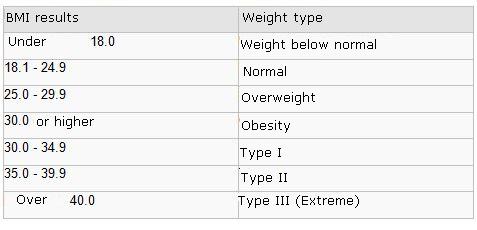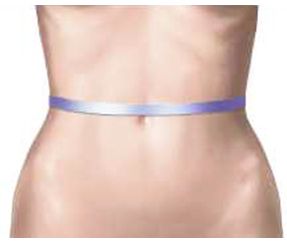How to determine body structure
It is done in the following way:
We measure the circumference of the wrist at the height of the radial styloid with a measuring tape (as you see in the image below).
After you measure it in centimetres, place the value (size) in the following equation:

The circumference of your wrist in centimetres.
The result you get is compared to the following standards:

Nowadays, a reduction in 10% of your current weight is used and widely accepted, since this reduces the risk of cardiovascular diseases.
Another way of knowing if your weight is inside normal parameters is by knowing your BMI (Body Mass Index), and the circumference of your waist.
Both parameters measure the risk of suffering other illnesses, such as diabetes, high blood pressure, in which obesity is directly incident.
2. 3 Body Mass Index (BMI)
Our Body Mass Index (BMI) is a measurement which relates the height and weight of a person, thus, we can tell if there is overweight or obesity.
This calculation is performed through a simple formula, which is dividing our weight by the square of our height.
To be able to know our Body Mass Index, we need 2 values:
Our exact height, and our exact weight.
Once we have these values, we can calculate the BMI using the following formula:

Let's calculate the BMI of a person who weights 75 kg. and has a height of 1.60 mt. Let's use the formula:
BMI = 75 / (1.60 * 1.60)
Answer: 1.60 * 1.60 = 2.56.
With this result, we continue with the formula:
BMI = 75 / 2.56
BMI = 29.296875
Body Mass Index results:

Going back to the previous example, the Body Mass Index of this person is 29.30. This means that this person is classified under «overweight», since he/she is within the limits of 25.0 - 29.9
The Body Mass Index is a widely accepted calculation method to determine the level of overweight or Obesity of a person. This formula was developed in the middle of the past century by LA Quetelet, a Belgian mathematician and it is based in the relationship between a person's height and weight.
2. 4 Waistline circumference
We need to measure the pelvic circumference, above the side bones of our hips, at the same height of our belly button. It needs to be measured without any air in our lungs, before we eat, and outside menstruation period in women.

BY measuring our waist, we determine the abdominal obesity, known as visceral fat, or android obesity, which is the most dangerous in terms of associated diseases.
Values considered as low risk or normal are those found under: in women 80 cm, in men 94 cm.
This measurement also helps us determine the lowering of fat mass. In many cases, our weight doesn't change (specially in people who exercise often). When we are undergoing a treatment to loose weight, it is advisable for us to have a control of how the size of our waist goes down.
Measuring our arm circumference
This measurement also helps when evaluating fat mass decrease.
The technique we need to use is:
Use a measuring tape. With your arm bent towards your back and forming a right angle, measure the distance between the collarbone and the appendage of the humerus. Find the mid-point between them. This is where you will measure the circumference, without applying any pressure.
Using all of these measurements, we can make a chart to record our results and see our evolution or improvement. These records should be measured weekly, but the measurement of your achievement should be performed in a monthly basis. In other words, we need to follow the treatment for one month, recording our weight and circumferences weekly. After 1 month, we can evaluate the success of the treatment objectively.
Control chart: Weight and circumferences.


